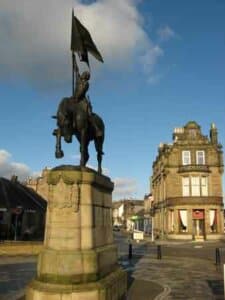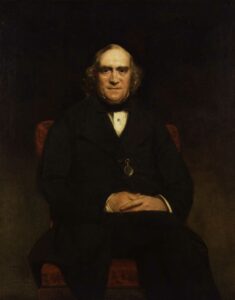James Wilson was born in Hawick, a small town at the heart of Teviotdale in the Scottish Borders, in 1805.
Wilson was the third son of 15 children. His father William, a Quaker, was a wealthy textile mill owner.
As a boy, James had attended Quaker schools although little evidence of his early education remains.
Although his boyhood ambition was to practise law, it seems Quaker rules prohibited the pursuit of this occupation forcing him to find alternative employment.
The continuing troubles of the East India Company would later provide a unique opportunity for the enterprising Scot.
At the age of 16, after attempting a number of other jobs, James was apprenticed to a local hat maker.

However, with one eye on the future, he continued to study in his spare time.
After only a few months, he progressed from apprentice to partner when his father bought the business for him and his elder brother William.
The business thrived and by the time he was 19, it had outgrown Hawick.
The brothers moved to London and continued trading until 1831 when the partnership was dissolved.
At this point, Wilson established James Wilson and Co, valued at £25,000, an enormous sum in the 19th century.
Scotchman inside every man
The young man from Hawick was now a wealthy man. He worked hard and believed strongly, as did his early hero Adam Smith, that there was a “Scotchman inside every man, with a universal desire to make money and a universal willingness to work for it.”
In 1836, he seized the opportunity to make a substantial financial return by investing in indigo, a natural blue dye that came from a plant cultivated mainly in British India.
Initially, he made a very ‘favourable’ return but the economic tide was turning and market conditions became volatile.
At a time when Britain was recognised as the world’s greatest economic power, the recession hit and, “disturbed the usual course of all trades.”
The price of indigo fell rapidly and Wilson lost part of his personal fortune. Despite this, his company survived.
During the early years of the 19th century unemployment and prices rose steeply in Britain bringing a severe recession that forced many people to live in abject poverty.
It was a situation made worse by the rapid increase in the country’s population, which had risen by over 30 percent between 1801 and 1831.
Corn Laws
Matters were further exacerbated by the high price of bread, a consequence of the Corn Laws, a system of taxes, designed to keep the price artificially high, introduced in 1815 after the defeat of Napoleon.

Seeing the devastating effect the legislation was having on an already weakened economy, Wilson joined other influential men and became a spokesman for the Ant-Corn Law League.
The League wasdedicated to persuading the government to abolish the hated laws.
Wilson’s campaign to get the Corn Laws abolished finally succeeded in 1846 after Prime Minister Robert Peel asked Parliament to repeal the Act.
His fight to rid the country of the Corn Law taxes didn’t stop him from working on other projects.
James Wilson Founder of the Economist Magazine
His long-held ambition to establish a newspaper specialising in economics, finance and commerce was realised when, on September 2, 1843, The Economist first appeared.
In the early days, Wilson wrote most of the content himself until handing the reins to his son-in-law Walter Bagehot who is now recognised as one of the magazine’s best editors.
Today the Economist Magazine continues as a well-respected, authoritative publication on international affairs, business news and economics.
Perhaps it was inevitable that such an influential figure should consider politics as the next step in an already rich and varied career.
In 1847, he was elected to Parliament as the Liberal member for Westbury.
Within six months, he was offered the position of Joint Secretary to the Board of Control for India which, among other things, managed the East India Company’s relationship with British India.
Australian Gold Rush
The Australian Gold Rush (1851) was the catalyst for his next venture. With miners from around the world pouring into the country there was an almost overnight need for, “The common necessities of life.”
Chartered Bank of India, Australia and China
Tea, coffee, rum, tobacco, and spices were all in great demand and James Wilson immediately saw the need for a new bank to facilitate this new and growing trade. On 9 October 1852, The Economist announced the issuing of the prospectus of the Chartered Bank of India, Australia and China.
The Chartered Bank was later merged with the Standard Bank (Standard Chartered Bank) and remains today a powerful force in modern global banking.
James Wilson: Finance Member of the Viceroy of India Council
By 1859, Lord Palmerston was Prime Minister and Wilson was offered the post of Finance Member of the Viceroy of India Council.

Probably more out of a sense of public duty rather than a real desire to turn his back on the House of Commons he left Britain for Calcutta.
In India “gigantic difficulties” awaited him as, in essence, the Chancellor of the Exchequer.
Sadly his work in India was cut short when, like many Westerners unused to the harsh climate, he died of dysentery. The date was August 11, 1860.
He is still remembered in the sub-continent as the person who introduced income tax, paper currency (Rupee) and a balanced budget.
Indeed he first “Evoked order out of the chaos of Indian finance.”
Throughout his life, Wilson was conscious of the unflattering image that many had of political economists. Of his chosen profession, he said,
“Some try to represent political economy as being a dry, cold, abstract science which has no warmth of feeling to spare on suffering humanity… This is far from the truth; on the contrary, political economy produces feelings so intense for the removal of the evils.”
James Wilson